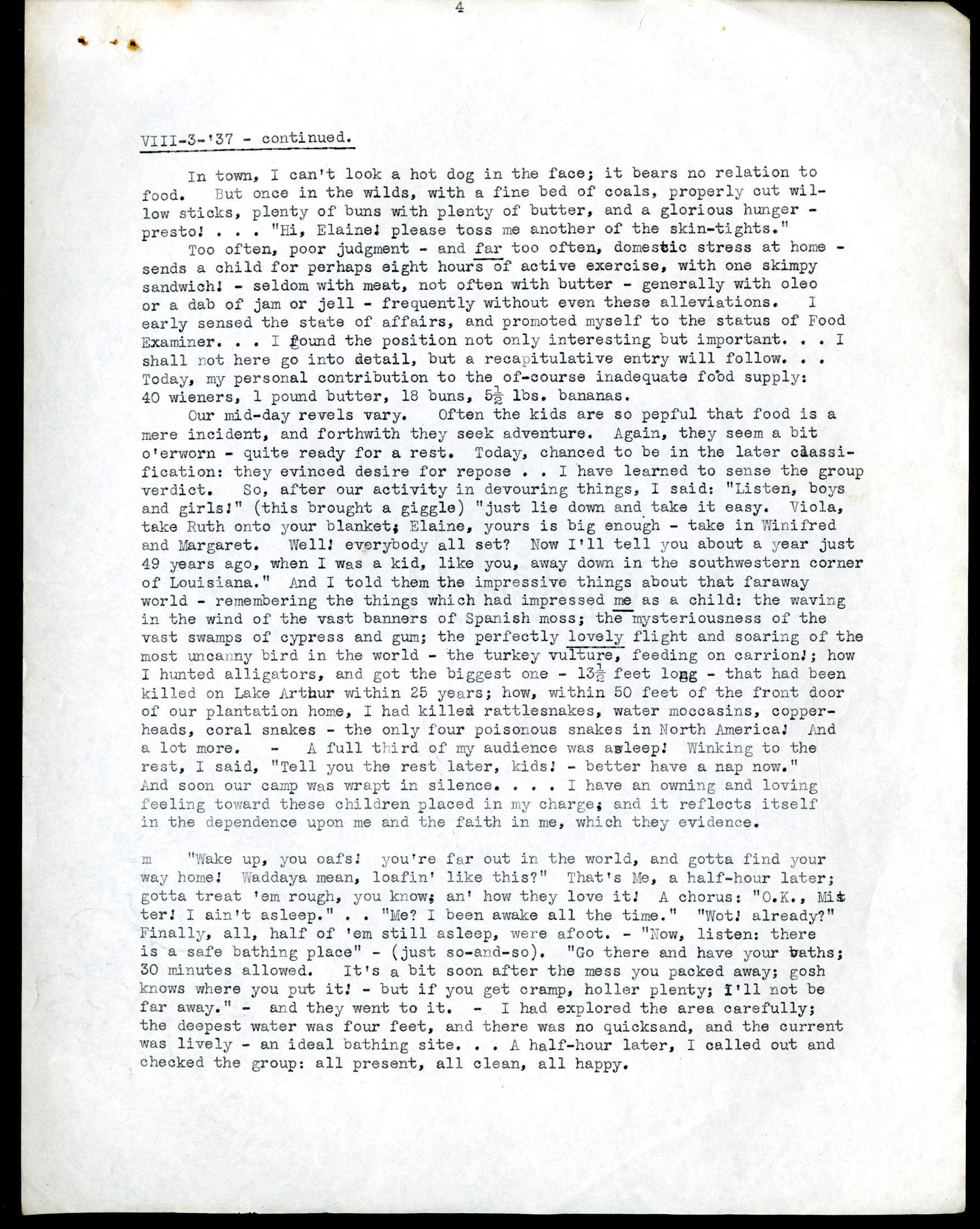Great Nebraska
Naturalists and ScientistsJune 5, 1937
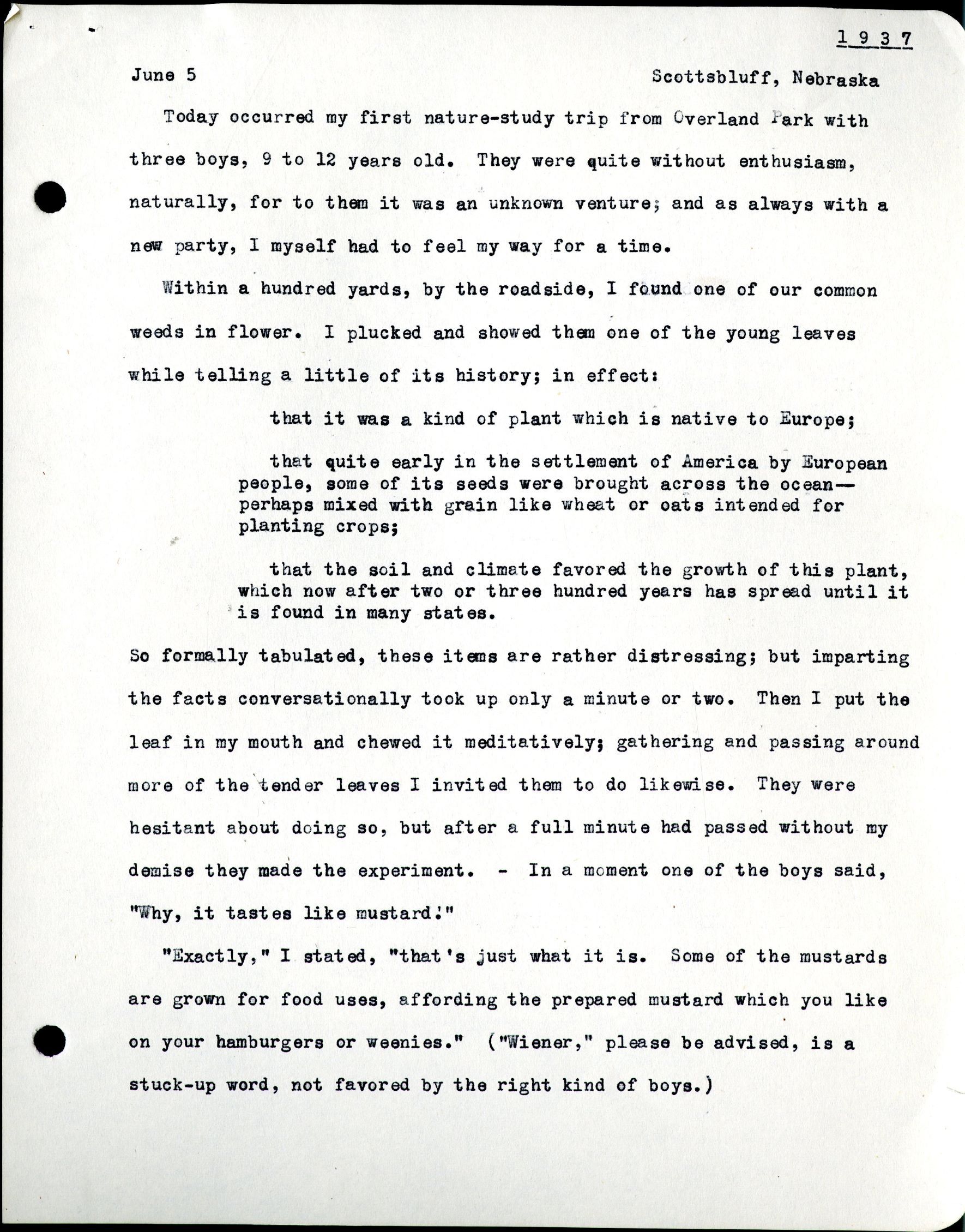
1937
Scottsbluff, Nebraska June 5
Today occurred my first nature-study trip from Overland Park with three boys, 9 to 12 years old. They were quite without enthusiasm, naturally, for to them it was an unknown venture; and as always with a new party, I myself had to feel my way for a time.
Within a hundred yards, by the roadside, I found one of our common weeds in flower. I plucked and shoed them one of the young leaves while telling a little of its history; in effect:
that it was a kind of plant which is native to Europe;
that quite early in the settlement of American by European people, some of its seeds were brought across the ocean – perhaps mixed with grain like wheat or oats intended for planting crops;
that the soil and climate favored the growth of this plant, which now after two or three hundred years has spread until it is found in many states.
So formally tabulated, these items are rather distressing; but imparting the facts conversationally took up only a minute or two. Then I put the leaf in my mouth and chewed it meditatively; gathering and passing around more of the tender leaves I invited them to do likewise. They were hesitant about doing so, but after a full minute had passed without my demise they made the experiment. – In a moment of the boys said, “Why, it tastes like mustard.”
“Exactly,” I stated, “that’s just what it is. Some of the mustards are grown for food uses, affording the prepared mustard which you like on your hamburgers or weenies.” (“Wiener,” please be advised, is a stuck-up word, not favored by the right kind of boys.)
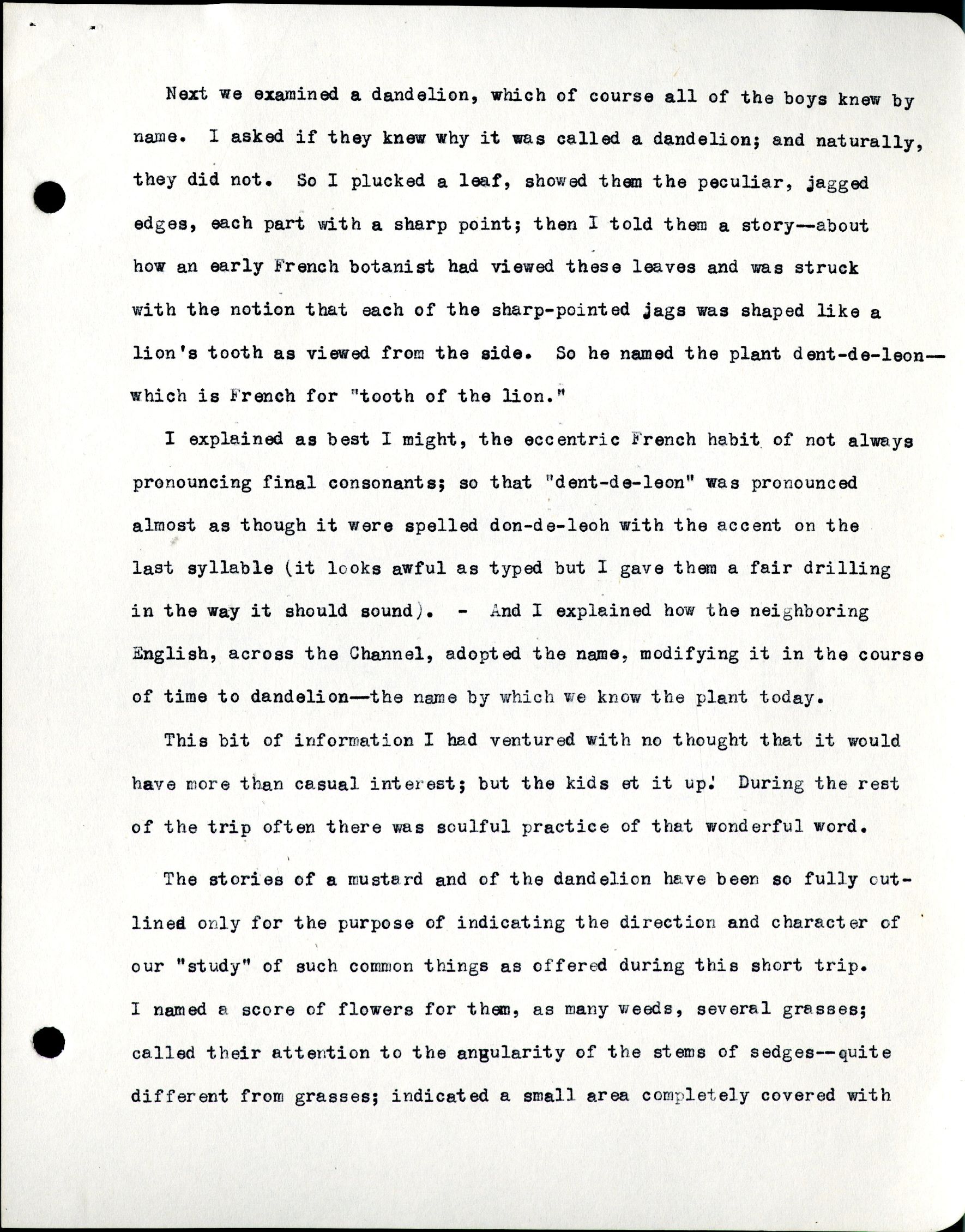
Next we examined a dandelion, which of course all of the boys knew by name. I asked if they knew why it was called a dandelion; and naturally, they did not. So I plucked a leaf, showed them the peculiar, jagged edges, each part with a sharp point; then I told them a story – about how an early French botanist had viewed these leaves and was struck with the notion that each of the sharp-pointed jags was shaped like a lion’s tooth as viewed from the side. So he named the plant dent-de-leon – which is French for “tooth of the lion.”
I explained as best I might, the eccentric French habit of not always pronouncing final consonants; so that “dent-de-leon” was pronounced almost as though it were spelled don-de-leoh with the accent on the last syllable (it looks awful as typed but I gave them a fair drilling in the way it should sound). – And I explained how the neighboring English across the Channel adopted the name modifying it in the course of the trip often there was soulful practice of that wonderful word.
The stories of a mustard and of the dandelion have been so fully outlined only for the purpose of indicating the direction and character of our “study” of such common things as offered during this short trip. I named a score of flowers for them, as many weeds, several grasses; called their attention to the angularity of the stems of sedges – quite different from grasses; indicated a small area completely covered with

only one kind of plant, while a like space near by had a mixture of several kinds, and explaining to them the reason. We saw and I named for them over twenty kinds of birds, of which of course they already knew several. The different kinds of clouds; how rust comes on iron; – we never ran out of subjects!
“Gee! this has been fine! When can we take another trip?”
June 7, 1937
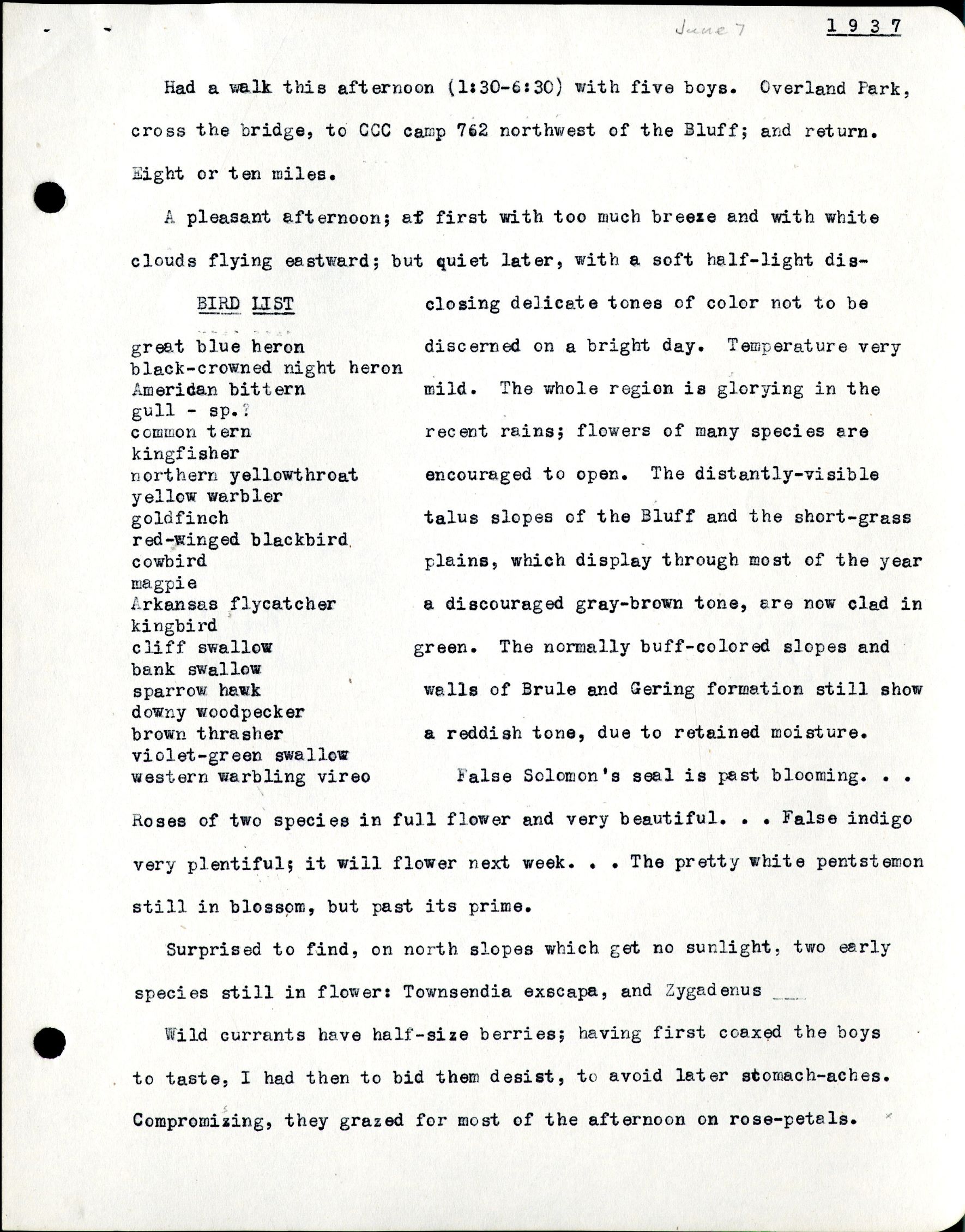
1937
Had a walk this afternoon (1:30-6:30) with five boys. Overland Park, cross the bridge, to CCC camp 762 northwest of the Bluff; and return. Eight or ten miles.
BIRD LIST
great blue heron black-crowned night heron American bittern gull – sp.? common tern kingfisher northern yellowthroat yellow warbler goldfinch red-winged blackbird cowbird magpie Arkansas flycatcher kingbird cliff swallow bank swallow sparrow hawk downy woodpecker brown thrasher violet-green swallow western warbling vireo
A pleasant afternoon; at first with too much breeze and with white clouds flying eastward; but quiet later, with a soft half-light disclosing delicate tones of color not to be discerned on a bright day. Temperature very mild. The whole region is glorying in the recent rains; flowers of many species are encouraged to open. The distantly-visible talus slopes of the Bluff and the short-grass plains, which display through most of the year a discouraged gray-brown tone, are now clad in green. The normally buff-colored slopes and walls of Brule and Gering formation still show a reddish tone, due to retained moisture.
False Solomon’s seal is past blooming. . . Roses of two species in full flower and very beautiful. . . False indigo very plentiful; it will flower next week. . . The pretty white pentstemon still in bloom, but past its prime.
Surprised to find, on north slopes which get no sunlight, two early species still in flower: Townsendia exscapa, and Zygadenus.
Wild currants have half-size berries; having first coaxed the boys to taste, I had then to bid them desist, to avoid later stomach-aches. Compromising, they grazed for most of the afternoon on rose-petals.
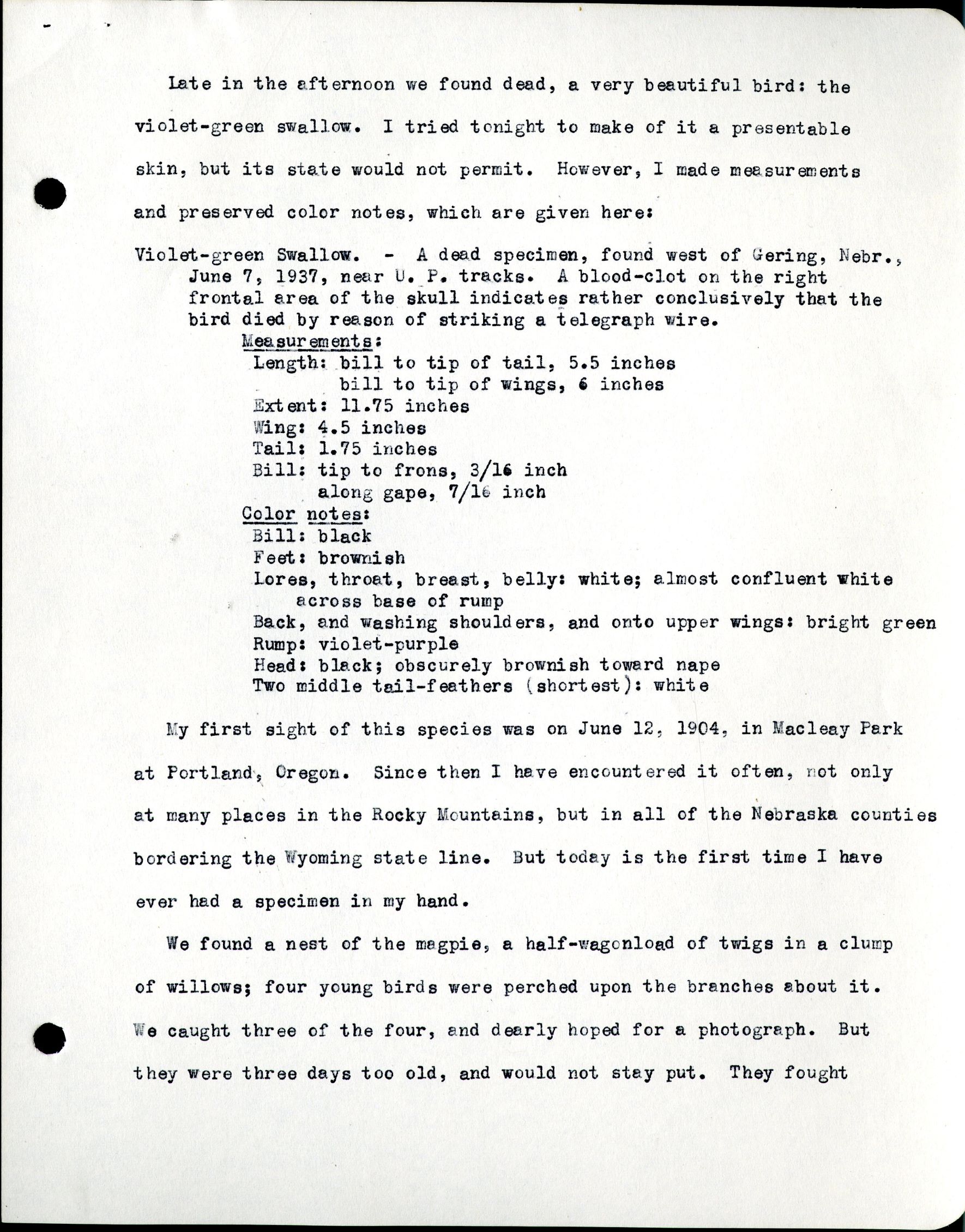
Late in the afternoon we found dead, a very beautiful bird: the violet-green swallow. I tried tonight to make of it a presentable skin, but its state would not permit. However, I made measurements and preserved color notes, which are given here:
Violet-green Swallow. – A dead specimen, found west of Gering, Nebr., June 7. 1937, near U. F. tracks. A blood clot on the right frontal area of the skull indicates rather conclusively that the bird died by reason of striking a telegraph wire.
Measurements: Length: bill to tip of tail, 5.5 inches bill to tip of wings, 6 inches Extent: 11.75 inches Wing: 4.5 inches Tail: 1.75 inches Bill: tip to fronts, 3/16 inch along gape, 7/16 inch
Color notes: Bill: black Feet: brownish Lores, throat, breast, belly: white; almost confluent white across base of rump. Back, and washing shoulders, and onto upper wings: bright green Rump: violet-purple Head: black; obscurely brownish toward nape Two middle tail-feathers (shortest): white
My first sight of this species was on June 12, 1904, in Macleay Park at Portland, Oregon. Since then I have encountered it often, not only at many places in the Rocky Mountains, but in all of the Nebraska counties bordering the Wyoming state line. But today is the first time I have ever had a specimen in my hand.
We found a nest of the magpie, a half-wagonload of twigs in a clump of willows; four young birds were perched upon the branches about it. We caught three of the four, and dearly hoped for a photograph. But they were three days too old, and would not stay put. They fought
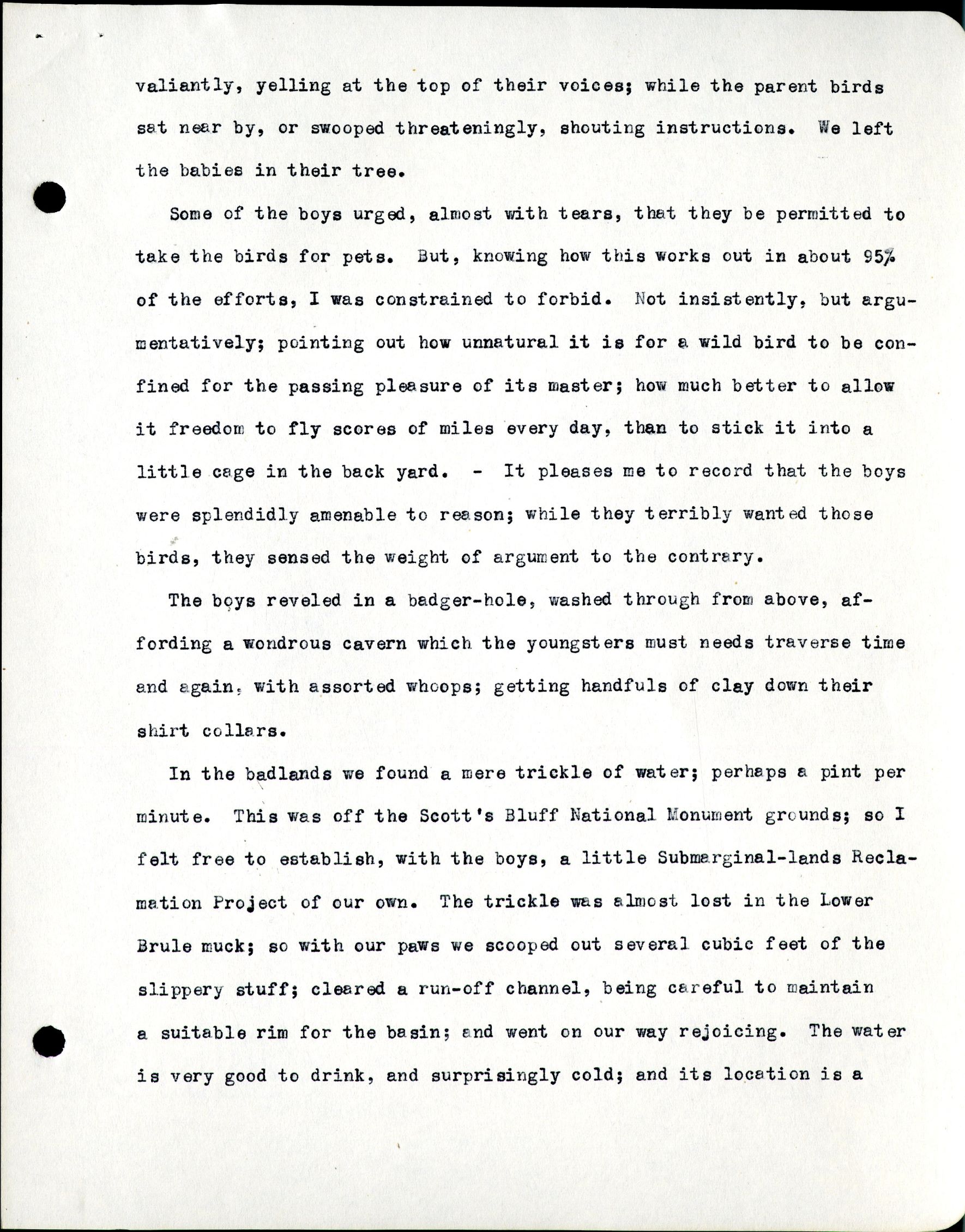
valiantly, yelling at the top of their voices; while the parent birds sat near by, or swooped threateningly, shouting instructions. We left the babies in their tree.
Some of the boys urged, almost with tears, that they be permitted to take the birds for pets. But, knowing how this works out in about 95% of the efforts, I was constrained to forbid. Not insistingly, but argumentatively; pointing out how unnatural it is for a wild bird to be confined for the passing pleasure of its master; how much better to allow it freedom to fly scores of miles every day, than to stick it into a little cage in the back yard. – It pleases me to record that the boys were splendidly amenable to reason; while they terribly wanted those birds, they sensed the weight of argument to the contrary.
The boys reveled in a badger-hole, washed through from above, affording a wondrous cavern which the youngsters must needs traverse time and again, with assorted whoops; getting handfuls of clay down their shirt collars.
In the badlands we found a mere trickle of water; perhaps a pint perminute. This was off the Scott’s Bluff National Monument grounds; so I felt free to establish, with the boys, a little Submarginal-lands Reclamation Project of our own. The trickle was almost lost in the Lower Brule much; so with our paws we scooped out several cubic feet of the slippery stuff; cleared a run-off channel, being careful to maintain a suitable rim for the basin; and went on our way rejoicing. The water is very good to drink, and surprisingly cold; and its location is a
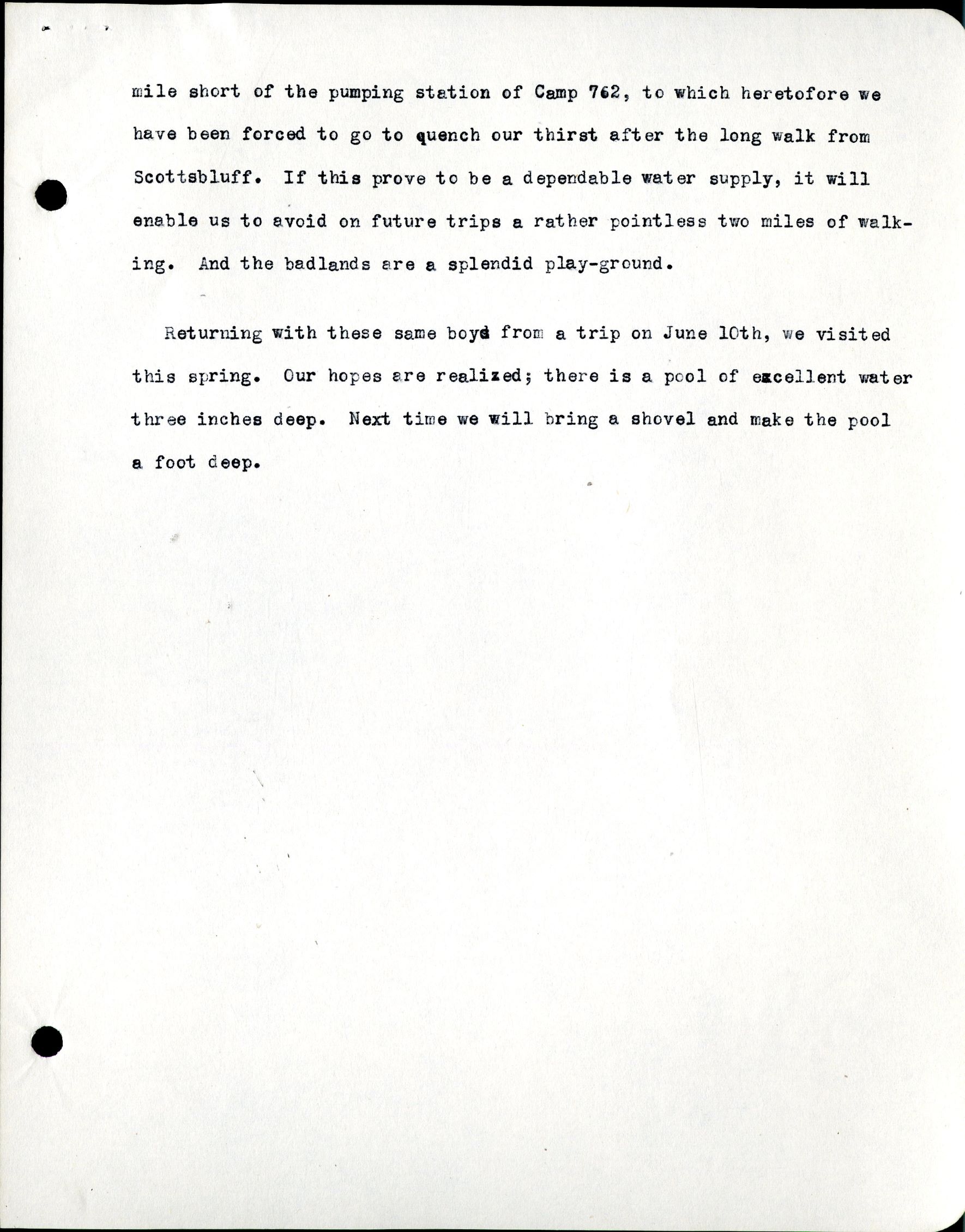
mile short of the pumping station of Camp 762, to which heretofore we have been forced to go to quench our thirst after the long walk from Scottsbluff. If this prove to be a dependable water supply, it will enable us to avoid on future trips a rather pointless two miles of walking. And the badlands are a splendid play-ground.
Returning with these same boys from a trip on June 10th, we visited this spring. Our hopes are realized; there is a pool of excellent water three inches deep. Next time we will bring a shovel and make the pool a foot deep.
June 12, 1937
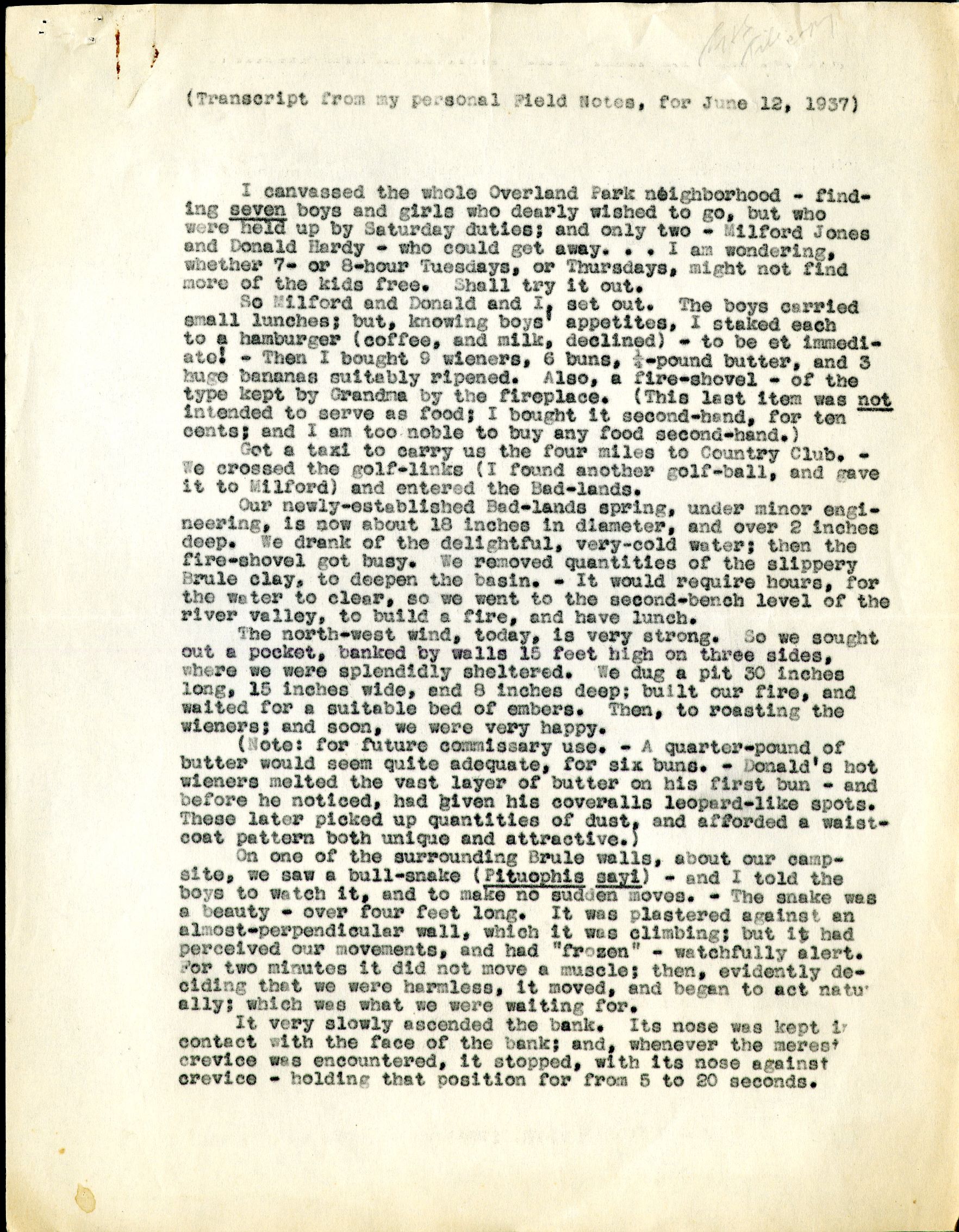
(Transcript from my personal Field Notes, for June 12, 1937)
I canvassed the whole Overland Park neighborhood -finding seven boys and girls who dearly wished to go, but who were held up by Saturday duties; and only two – Milford Jones and Donald Hardy – who could get away. . . I am wondering, whether 7 – or 8-hour Tuesdays, or Thursdays, might not find more of the kids free. Shall try it out.
So Milford and Donald and I set out. The boys carried small lunches; but, knowing boys’ appetites, I staked each to a hamburger (coffee, and milk, declined) – to be et immediate! – Then I bought 9 wieners, 6 buns, 1/4-pound butter, and 3 huge bananas suitably ripened. Also, a fire-shovel – of the type kept by Grandma by the fireplace. (This last item was not intended to serve as food; I bought it second-hand, for ten cents; and I am too noble to buy any food second-hand.)
Got a taxi to carry us the four miles to Country Club. – We crossed the golf-links (I found another golf-ball, and gave it to Milford) and entered the Bad-lands.
Our newly-established Bad-lands spring, under minor engineering, is now about 18 inches in diameter, and over 2 inches deep. We drank of the delightful, very-cold water; then the fire-shovel got busy. We removed quantities of the slippery Brule clay, to deepen the basin. – It would require hours, for the water to clear, so we went to the second-bench level of the river valley, to build a fire, and have lunch.
The north-west wind, today, is very strong. So we sought out a pocket, banked by walls 15 feet high on three sides, where we were spendidly sheltered. We dug a pit 30 inches long, 15 inches wide, and 8 inches deep; built our fire, and waited for a suitable bed of embers. Then, to roasting the wieners; and soon, we were very happy.
(Note: for future commissary use – A quarter pound of butter would seem quite adequate for six buns. – Donald’s hot wieners melted the vast layer of butter on his first bun – and before he noticed, had given his coveralls leopard-like spots. These later picked up quantities of dust, and afforded a waistcoat pattern both unique and attractive.)
On one of the surrounding Brule walls, about our campsite, we saw a bull-snake (Pituophis sayi) – and I told the boys to watch it, and to make no sudden moves. – The snake was a beauty – over four feet long. It was plastered against an almost-perpendicular wall, which it was climbing; but it had perceived our movements, and had “frozen” – watchfully alert. For two minutes it did not move a muscle; then, evidently deciding that we were harmless, it moved, and began to act naturally; which was what we were waiting for.
It very slowly ascended the bank Its nose was kept in contact with the face of the bank; and whenever the merest crevice was encountered, it stopped, with its nose against crevice – holding that position for from 5 to 20 seconds.
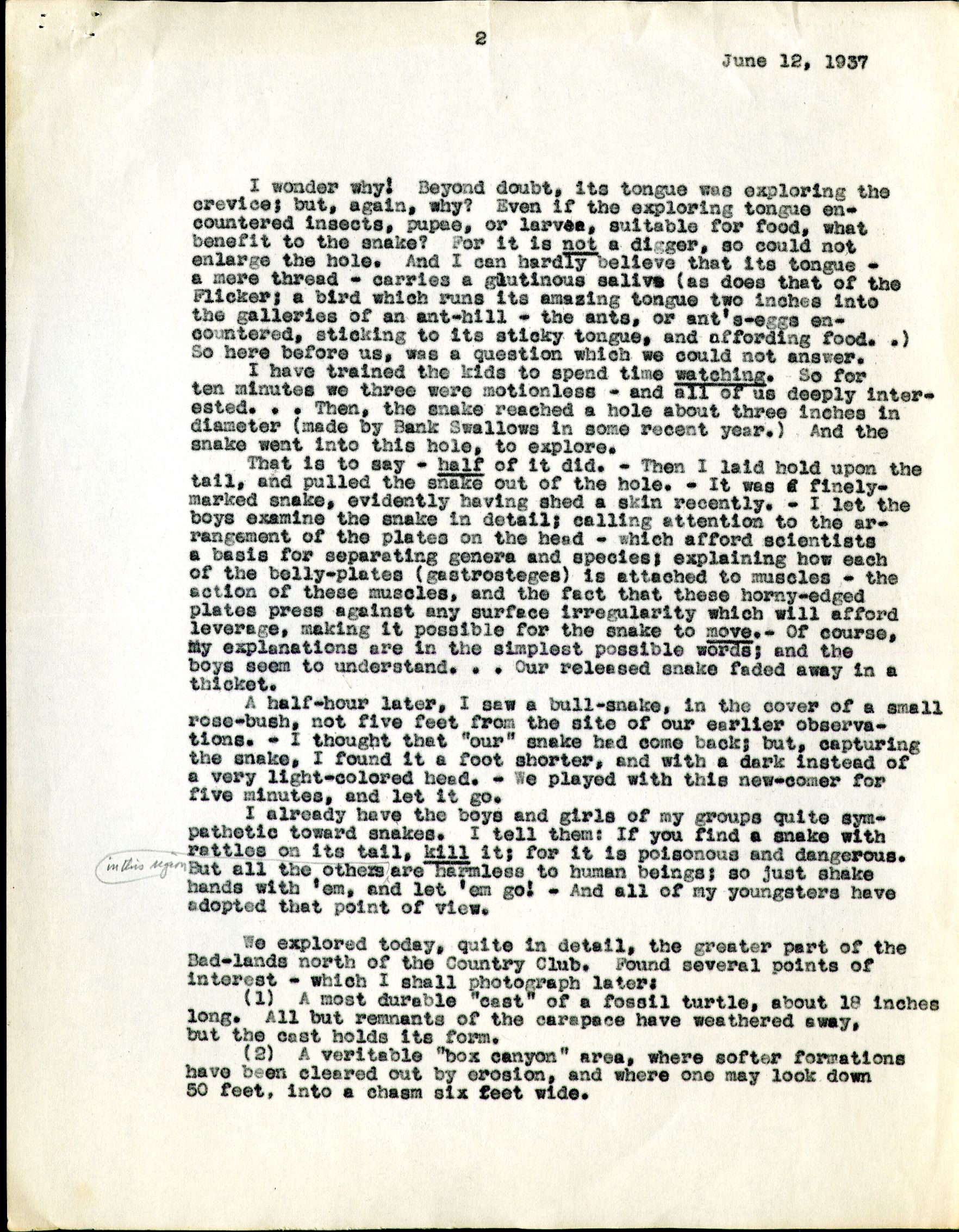
June 12, 1937
I wonder why! Beyond doubt, its tongue was exploring the crevice; but again, why? Even if the exploring tongue encountered insects, pupae, or larvae, suitable for food what enlarge the hole. And I can hardly believe that its tongue – a mere thread – carries a glutinous salvia (as does that of the Flicker; a bird which runs its amazing tongue two inches into the galleries of an ant-hill – the ants, or ant’s-eggs encountered, stickering to its sticky togue, and affording food. .)
I have trained the kids to spend time watching. So for ten minutes we three were motionless – and all of us deeply interested… Then, the snake reached a hole about three inches in diameter (made by Bank Swallows in some recent year.) And the snake went into this hole to explore.
That is to say – half of it did. – Then I laid hold upon the tail, and pulled the snake out of the hole. – It was a finely-marked snake, evidently having shed a skin recently. – I let the boys examine the snake in detail; calling attention to the arrangement of the plates on the head – which afford scientists a basis for separating genera and species; explaining how each of the belly-plates (gastrosteges) is attached to muscles – the action of these muscles, and the fact that these horny-edged plates press against any surface irregularity which will afford leverage, making it possible for the snake to move. – Of course, My explanations are in the simplest possible words; and the boys seem to understand.. Our released snake faded away in a thicket
A half-hour later, I saw a bull-snake, in the cover of a small rose-brush, not five feet from the site of our earlier observations. – I thought that “our” snake had come back; but, capturing the snake, I found it a foot shorter, and with a dark instead of a very light-colored head. – We played with this new-comer for five minutes, and let it go.
I already have the boys and girls of my groups quite sympathetic towards snakes. I tell them: If you find a snake with rattles on its tail, kill it; for it is poisonous and dangerous. But, all the others are harmless to human beings; so just shake hands with ‘em, and let ‘em go! – And all of my youngsters have adopted that point of view.
We explored today, quite in detail, the greater part of the Bad-lands north of the Country Club. Found several points of interest – which I shall photograph later: (1) A most durable “cast” of a fossil turtle, about 18 inches long. All but remnants of the carapace have weathered away, but the cast holds its form.(2) A veritable “box canyon” area, where softer formations have been cleared out by erosion, and where one may look down 50 feet, into a chasm six feet wide.
July 9, 1937

Scottsbluff, Nebr. Friday, July 9, 1937
A trip to the Badlands with the largest group to date – eight boys and six girls.
At the south end of the Scottsbluff-Gering bridge we turned westward to traverse the bottomlands of the North Platte thro the cottonwoods and willows. I was able to point out many plants and shrubs in blossom – thistle poppy, snow-berry, cleome, blue vervain, star-grass, false Solomon’s seal; and was pleased to not that several of the kids who had taken earlier trips with me remembered the names which I had given them.
I introduced, to those who did not know it, the poison ivy with its three leaves; also, the harmless five-leafed Virginia creeper. Gradually I am persuading the youngsters, especially when taking a woodland or brush-land trip, to wear slacks, not shorts – because of the better protection from poison ivy, rose bushes, cacti.
I permitted the eight boys to go swimming, in a restricted area which I knew to be safe; the girls and I went botanizing. After a half-hour I called in the bathers and let the six girls take a whirl at it; they all dug up bathing suits, or something, and had their half-hour, while I policed the hectic males by instructing them in a game which held us all within a square rod or two, densely absorbed.
We built a fire and roasted our weiners; great fun, all of us! Absorbing a bit of woodcraft. – Each of the youngsters is instructed to bring his lunch; but on early trips I was positively distressed to not how poorly provided many of them were. So form my own funds I “build up” enough that all may be decently fed, counting in their provisions. This effort on my part is quite as selfish as it is benevolent. For eight hours of scampering and whooping and climbing simply hollers for food. I wish them to be not only benefited by the exercise, but happy; and a hungry child can’t be very happy.
(This trip carried us into the Badlands, as my personal field-notes proclaim; but as it proved less interesting then some others to be transcribed, I omit details.)
Tuesday, July 13, 1937
I took several photographs on our latest trip, July 9th; postcard size, Speed Graphic camera fitted with Zeiss-Tesar lens. Among them was a picture of our group of fourteen; and today a print was delivered, or delegated for delivery, to each of the participants. This is my regular practice, and I am convined, from the enthusiastic reception accorded these prints, that as an “advertising medium” it is of rare value in popularizing our Recreation effort.
—
Today, it was hard going to assemble a party for a trip afield. I visited a dozen homes; most of the kids had been assigned duties. Some boys had to help father; several boys and girls were held by a rehearsal for a coming entertainment; two girls had to iron; one was attending a friend who was ill. And so on. I was impressed anew with sense of the economic importance of these children in both household and business routine. It surprised me
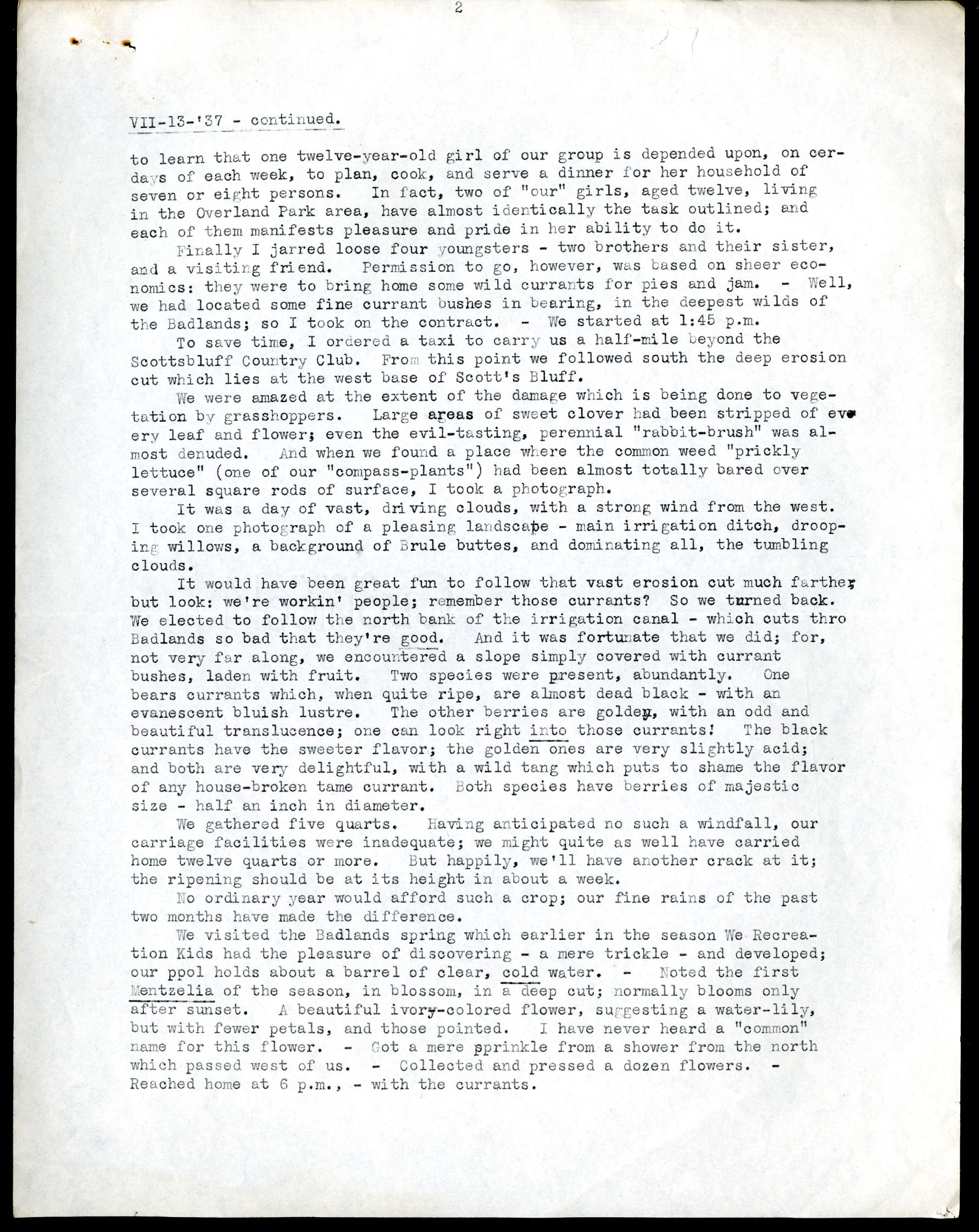
VII-13-’37 – continued.
to learn that one twelve-year-old girl of our group is depended upon, on cerdays of each wee4k, to plan, cook, and serve a dinner for her household of seven or eight persons. In fact, two of “our” girls, aged twelve, living in the Overland Park area, have almost identically the task outlined; and each of them manifests pleasure and pride in her ability to do it.
Finally I jarred loose four youngsters – two brothers and their sister, and a visiting friend. Permission to go, however, was based on sheer economics; they were to bring home some wild currants for pies and jam. – Well, we had located some fine currant bushes in bearing, in the deepest wilds of the Badlands; so I took on the contract. – We started at 1:45 p.m.
To save time, I ordered a taxi to carry us a half-mile beyond the Scottsbluff Country Club. From this point we followed south the dep erosion cut which lies at the west base of Scott’s Bluff.
We were amazed at the extent of the damage which is being done to vegetation by grasshoppers. Large areas of sweet clover had been stripped of every leaf and flower; even the evil-tasting, perennial “rabbit-brush” was almost denuded. And when we found a place where the common weed “prickly lettuce” (one of our “compass-plants”) had been almost totally bared over several square rods of surface, I took a photograph.
It was a day of vast, driving clouds, with a strong wind form the west. I took one photograph of a pleasing landscape – main irrigation ditch, drooping willows, a background of Brule buttes, and dominating all, the tumbling clouds.
It would have been great fun to follow that vast erosion out much farther, but look: we’re workin’ people; remember those currants? So we turned back. We elected to follow the north bank of the irrigation canal – which cuts thro Badlands so bad that they’re good. And it was fortunate that we did; for, not very far along, we encountered a slope simply covered with currant bushes, laden with fruit. Two species were present, abundantly. One bears currants which, when quite ripe, are almost dead black – with an evanescent bluish lustre. The other berries are golden, with an odd and beautiful translucence; one can look right into those currants! The black currants have the sweeter flavor; the golden ones are very slightly acid; and both are very delightful, with a wild tang which puts to shame the flavor of any house-broken tame currant. Both species have berries of majestic size – half an inch in diameter.
We gathered five quarts. Having anticipated no such a windfall, our carriage facilities were inadequate; we might quite as well have carried home twelve quarts or more. But happily, we’ll have another crack at it; the ripening should be at its height in about a week.
No ordinary year would afford such a crop; our fine rains of the past two months have made the difference.
We visited the Badlands spring which earlier in the season We Recreation Kids had the pleasure of discovering – a mere trickle – and developed; our ppol holds about a barrel of clear, cold water. – Noted the first Mentzelia of the season, in blossom, in a deep cut; normally blooms only after sunset. A beautiful ivory-colored flower, suggesting a water-lily, but with fewer petals, and those pointed. I have never heard a “common” name for this flower. – Got a mere pprinkle from a shower from the north which passed west of us. – Collected and pressed a dozen flowers. – Reached home at 6 p.m., – with the currants.
August 3, 1937
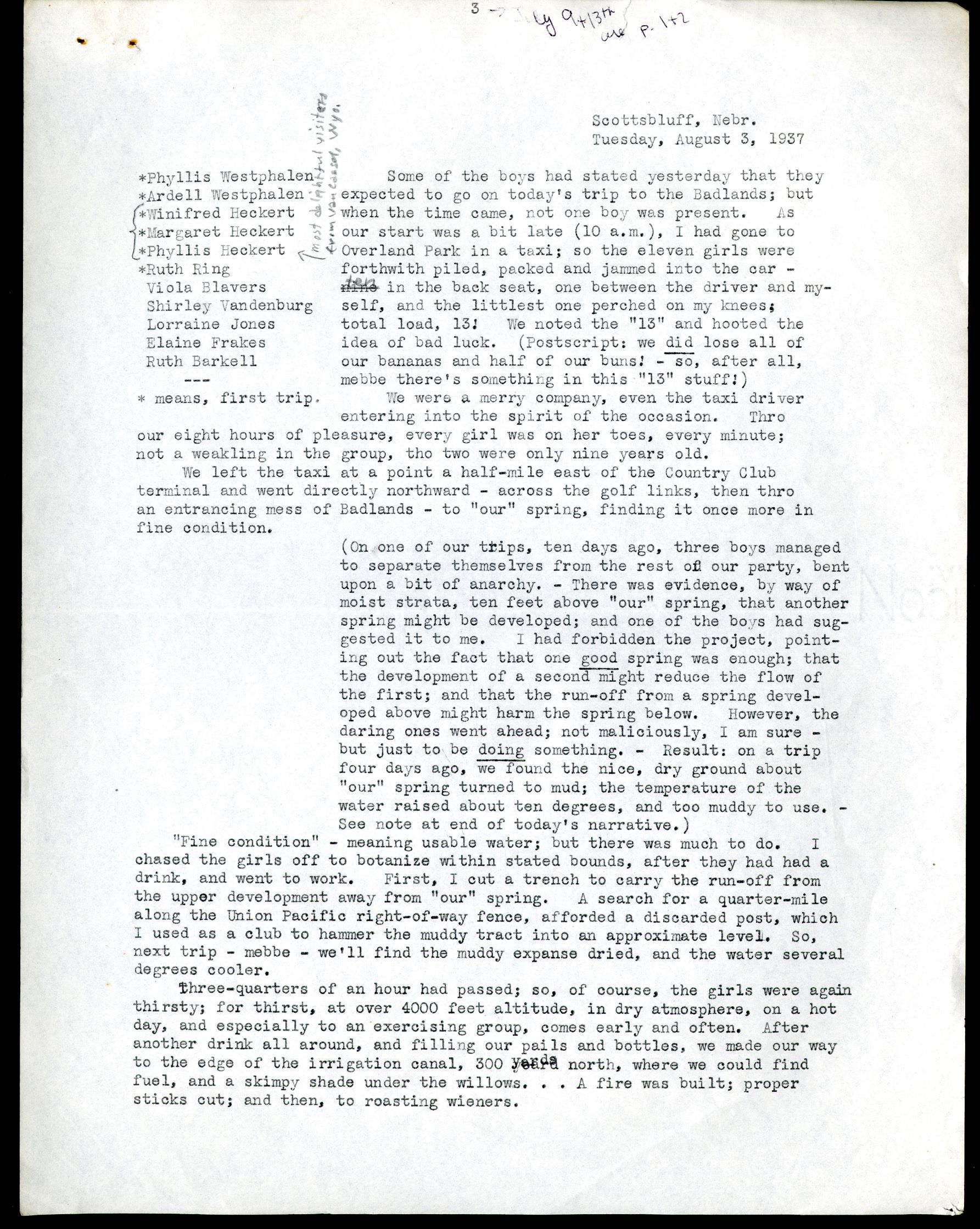
Scottsbluff, Nebr. Tuesday, August 3, 1937
*Phyllis Westphalen *Ardel Westphalen *Winifred Heckert *Margaret Heckert *Phyllis Heckert *Ruth Ring Viola Blavers Shirley Vandenburg Lorraine Jones Elaine Frakes Ruth Barkell
—
* means, first trip.
Some of the boys had stated yesterday that they expected to go on today’s trip to the Badlands; but when the time came, not one boy was present. As out start was a bit late (10 a.m.), I had gone to Overland Park in a taxi; so the eleven girls were forthwith piled, packed and jammed into the car – nine ten in the backseat, one between the driver and myself, and the littlest one perched on my knees; total load, 13. We noted the “13” and hooted the idea of bad luck. (Postscript: we did lose all of our bananas and half of our buns; – so, after all, mebbe there’s something in this “13” stuff!)
We were a merry company, even the taxi driver entering into the spirit of the occasion. Thro our eight hours of pleasure, every girl was on her toes, every minute; not a weakling in the group, tho two were only nine years old.
We left the taxi at a point a half-mile east of the Country Club terminal and went directly northward – across the golf links, then thro an entrancing mess of Badlands – to “our” spring, finding it once more in fine condition.
(On one of our trips, ten days ago, three boys managed to separate themselves from the rest of our party, bent upon a bit anarchy. – There was evidence, by way of moist strata, ten feet above “our” spring, that another spring might be developed; and one of the boys had suggested it to me. I had forbidden the project, pointing out the fact one good spring was enough; that the development of a second might reduce the flow of the first; and that the run-off from a spring developed about might harm the spring below. However, the daring ones went ahead; not maliciously I am sure – but just to be doing something. – Result: on a trip four days ago, we found the nice, dry ground about “our” spring turned to mud; the temperature of the water raised about ten degrees, and too muddy to use. – See note at the end of today’s narrative.)
“Fine condition” – meaning usable water; but there was much to do. I chased the girls off to botanize within stated bounds, after they had had a drink, and went to work. First, I cut a trench to carry the run-off from the upper development away from “our” spring. A search for a quarter-mile along the Union Pacific right-of-way fence, afforded a discard post, which I used as a club to hammer the muddy tract into an approximate level. So, next trip – mebbe – we’ll find the muddy expanse dried, and the water several degrees cooler.
Three-quarters of an hour had passed; so, of course, the girls were again thirsty; for thirst, at over 4000 feet altitude, in dry atmosphere, on a hot day, and especially to an exercising group, comes early and often. After another drink all around, and filling our pails and bottles, we made our way to the edge of the irrigation canal 300 yards north, where we could find fuel, and a skimpy shade under the willows. . . A fire was built; proper sticks out; and then, to roasting wieners.
VIII-3-’37 – continued.
In town, I can’t look a hot dog in the face; it bears no relation to food. But once in the wilds,with a fine bed of coals, properly out willow sticks, plenty of buns with plenty of butter, and a glorious hunger – presto! . . . “Hi, Elaine! Please toss me another of the skin-tights.”
Too often, poor judgement – and far too often, domestic stress at home – sends a child for perhaps eight hours of active exercise, with one skimpy sandwich! – seldom with meat, not often with butter – generally with oleo or a dab of jam or jell – frequently without even these alleviations. I early sensed the state of affairs, and promoted myself to the status of Food Examiner. . . I found the position not only interesting but important. . . I shall not here go into detail, but a recapitulative entry will follow. . . Today, my personal contribution to the of-course inadequate food supply: 40 wieners, 1 pound of butter, 18 buns, 5 ½ lbs. bananas.
Our mid-day revels vary. Often the kids are so pepful that food a mere incident, and forthwith they seek adventure. Again, they seem a bit o’erworn – quite ready for a rest. Today, chanced to be in the later classification: they evinced desire for repose. . . I have learned to sense the group verdict. So, after our activity in devouring things, I said: “Listen, boys and girls!” (this brought a giggle) “just lie down and take it easy. Viola, take Ruth onto your blanket; Elaine, yours is big enough – take in Winifred and Margaret. Well; everybody all set? Now I’ll tell you about a year just 49 years ago, when I was a kid, like you, away down in the southwestern corner of Louisiana.” And I told them the impressive things about that faraway world – remembering the things which had impressed me as a child; the waving in the wind of the vast banners of Spanish moss; the mysteriousness of the vast swamps of cypress and gum; the perfectly lovely flight and soaring of the most uncanny bird in the world – the turkey vulture, feeding on carrion!; how I hunted allighttp://sandhillsarchive.unl.edu/wp-content/uploads/2021/05/321301-01068.jpgators, and got the biggest one – 13 ½ feet long – that had been killed on Lake Arthur within 25 years; how, within 50 feet of the front door of our plantation home, I had killed rattlesnakes, water moccasins, copperheads, coral snakes – the only four poisonous snakes in North America! And a lot more. – A full third of my audience was asleep! Winking to the rest, I said, “Tell you the rest later, kids! – better have a nap now.” And soon our camp was wrapt in silence. . . . I have an owning and loving feeling towards these children placed in my charge, and it reflects itself in the dependence upon me and the faith in me, which they evidence.
m “Wake up, you oafs! you’re far out in the world, and gotta find your way home! Waddaya mean, loafin’ like this?” That’s Me, a half-hour later; gotta treat ‘em rough, you know; an’ how they love it! A chorus: “O.K., Mister! I ain’t asleep.”. . “Me? I been awake all the time.” “Wot! already?” Finally, all, half of ‘em still asleep, were afoot. – “Now, listen: there is a safe bathing place” – (just so-and-so). “Go there and have your baths; 30 minutes allowed. It’s a bit soon after the mess you packed away; gosh knows where you put it! – but if you get cramp, holler plenty; I’ll not be far away.” And they went to it. – I had explored the area carefully; the deepest water was four feet, and there was no quicksand, and the current was lively – an ideal bathing site. . . A half-hour later, I called out and checked the group: all present, all clean, all happy.
August 3, 1937
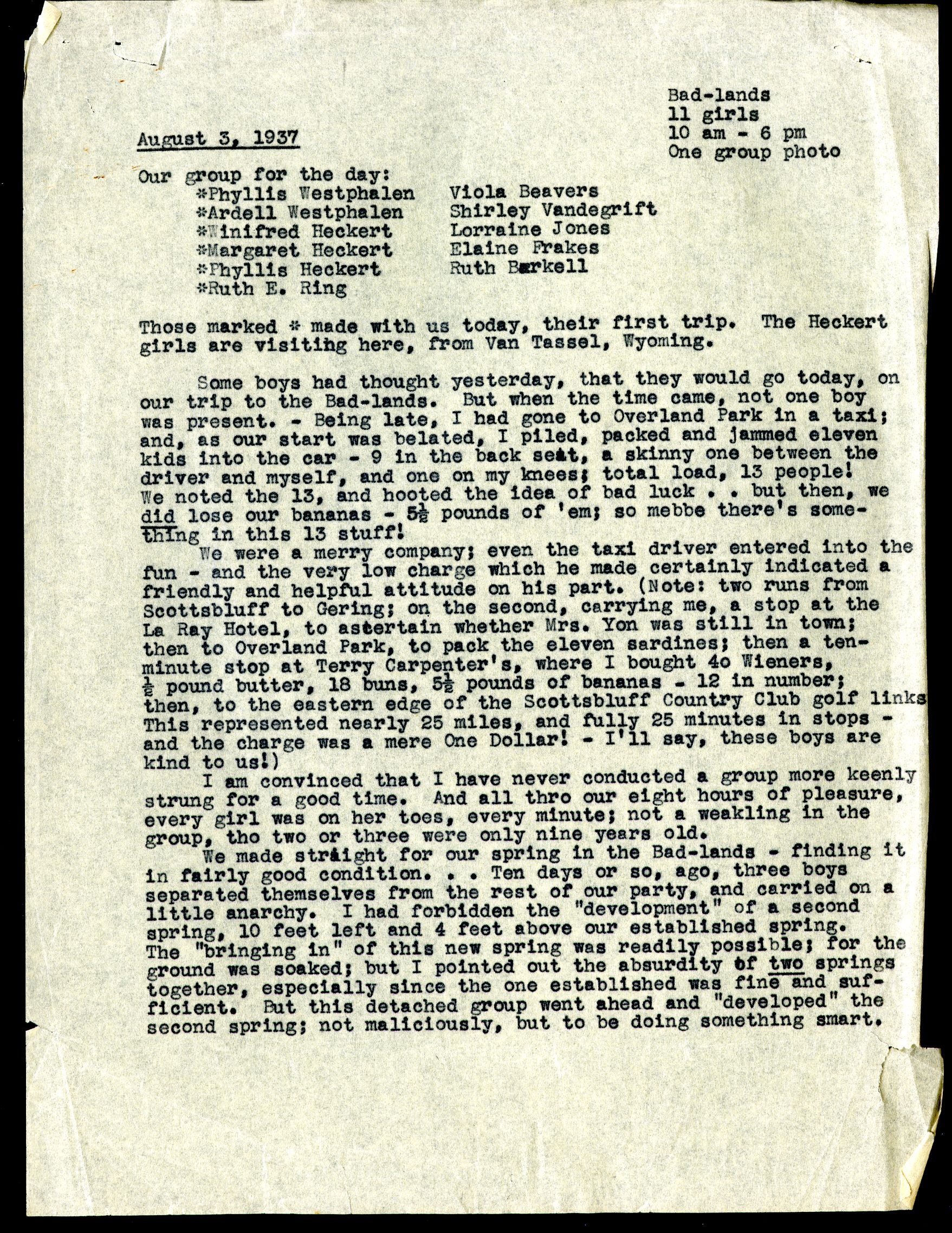
Bad-Lands 11 Girls 10 am – 6 pm One Group photo
August 3, 1937
Our group for the day: *Phyllis Westphalen Viola Blavers *Ardel Westphalen Shirley Vandenburg *Winifred Heckert Lorraine Jones *Margaret Heckert Elaine Frakes *Phyllis Heckert Ruth Barkell *Ruth Ring
Those marked * made with us today, their first trip. The Heckert girls are visiting here, from Van Tassel, Wyoming.
Some of the boys had thought yesterday, that they expected to go on today’s trip to the Bad-Lands. But when the time came, not one boy was present. Being late, I had gone to Overland Park in a taxi; and, as our start was belated, I piled, packed and jammed eleven kids into the car – 9 in the back seat, a skinny one between the driver and myself, and one on my knees; total load, 13 people! We noted the 13, and hooted the idea of bad luck. . but then, we did lose our bananas – 5 ½ pounds of ‘em; so mebbe there’s something in this 13 stuff!
We were a merry company; even the taxi driver entering into the fun – and the very low charge which he made certainly indicated a friendly and helpful attitude on his part. (Note: two runs from Scottsbluff to Gering; on the second, carrying me, a stop at the La Ray Hotel, to ascertain whether Mrs. Yon was still in town; then to Overland Park, to pack the eleven sardines; then a ten minute stop at Terry Carpenter’s, where I bought 40 Wieners, ½ pound butter, 18 buns, 5 ½ pounds of bananas – 12 in number; then, to the eastern edge of the Scottsbluff Country Club golf links. This represented nearly 25 miles, and fully 25 minutes in stops – and the charge was a mere One Dollar! – . I’ll say, these boys are kind to us!)
I am convinced that I have never conducted a group more keenly strung for a good time. And all thro our eight hours of pleasure, every girl was on her toes, every minute; not a weakling in the group, tho two or three were only nine years old.
We made straight for our spring in the Bad-lands – finding it in fairly good condition. . . Ten days or so, ago, three boys separated themselves from the rest of our party, and carried on a little anarchy. I had forbidden the “development” of a second spring, 10 feet left and 4 feet above our established spring. The “bringing in” of this new spring was readily possible; for the ground was soaked; but I pointed out the absurdity of two springs together, especially since the one established was fine and sufficient. But this detached group went ahead and “developed” the second spring; not maliciously, but to be doing something smart.

Result: the nice, dry ground about “our” spring became a muddy expanse: and water from the new spring about – of perhaps 5% the flow of the established spring – flowed in large part, warmed by exposure to the sun, into “our” spring, raising the temperature of our supply by at least 5 degrees. . . So today, I played surveyor and engineer – cutting a trench to carry run-off from the upper spring, away from “our” spring. So maybe, next trip, we’ll find the muddy expanse dried, and “our” spring several degrees colder. . . The day was sufficiently hot that we called several times at the spring, to relieve our thirst.
After drinking our fill, and after the girls had filled the seven half-pint bottles (with screw caps) which I had brought along for them, we carried away two q uarts additional – in a pial brought along for picking wild currants – and made our way to the upper benches of the river valley, where we could find fuel and shade. A fire was built; and the, to roasting the wieners. . . In town, I simply can’t look a hot dog in the face; it bears no relation to food. But once, in the wilds, with a fine bed of coals, properly cut willow sticks, plenty of buns with plenty of butter, and a glorious hunger. . . presto! – wieners become Food; and their processing a positive delight. – The kids are supposed to roll their own; but I always supplement their supply.
Very soon after our hearty lunch, I permitted the girls – all had brought bathing suits – to a take a swim in the irrigation canal. It was bank-full, with a swift current; and the water was from three to four feet deep. I was near enough to risk “cramp” – so I let ‘em go to it on full stomachs; and no disaster came. They had a wonderful time.
Then – since some of us had come to pick wild currants – we went via the spring, thro tortuous badlands eros ion cuts (quite an education, to those who had before traversed them) to the currant patches bordering the other irrigation canal. The currant-pickers were only four or five in number; the others went for another swim, in an area which I knew to be free from holes and danger. . . Currants which are of two species – one ripening black, one ripening with a glorious orange hue – are found here. Both are of fine flavor. In dry seasons, they are rather small; but this year’s fine rains have built them pp, and hundreds of those picked were a full half-inch in diameter. So late in the season, the birds, grasshoppers, ants, have damaged much fruit; but we still found plenty of good ones. I gave Shirley Vandagrift over a pint, to fill her pail, so that she might go swimming; and, later, delivered about three quarts to Mrs. Shuck, who nursed me so loyally after my auto accident – which held me bedfast from December 16th into March.
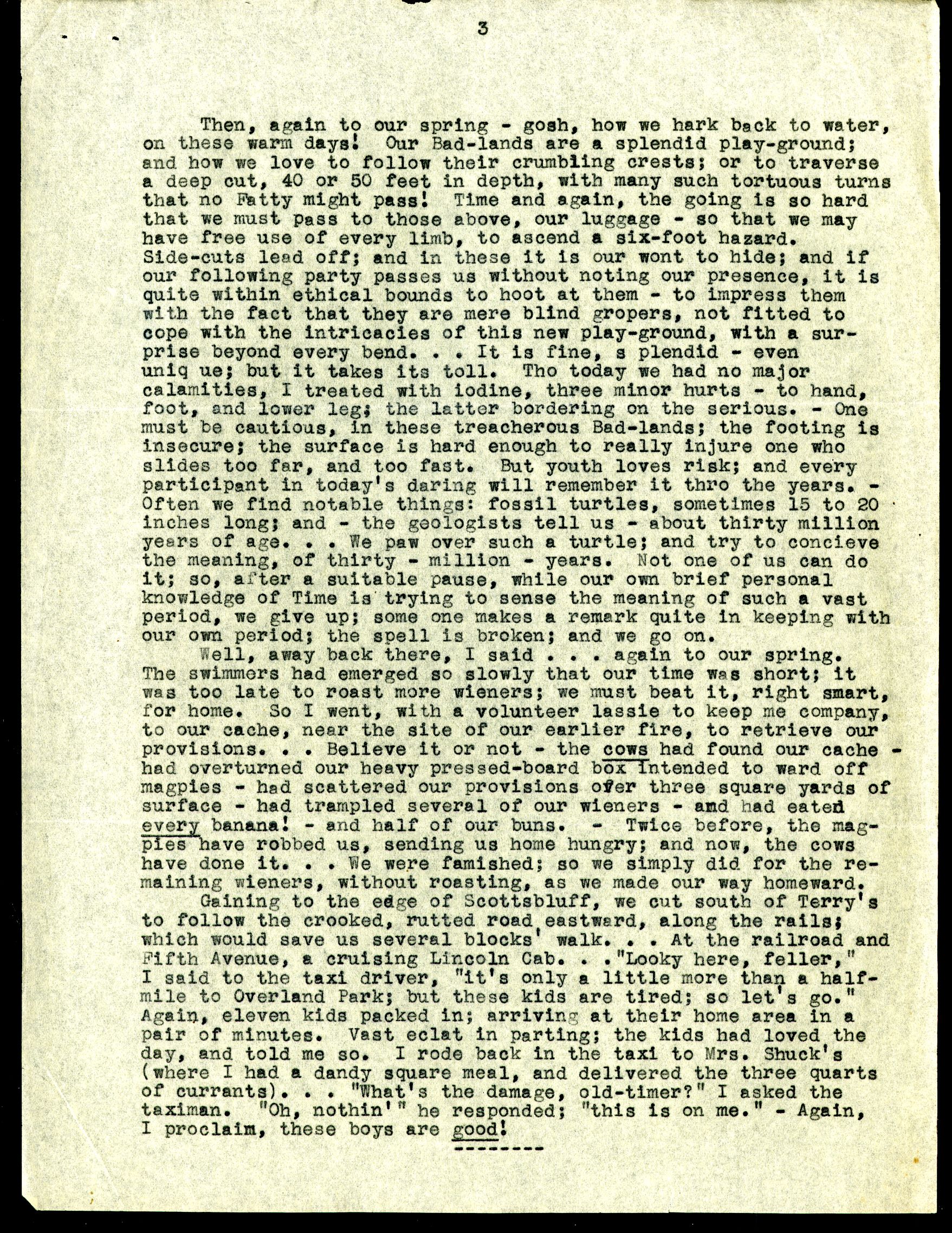
Then, again to our spring – gosh, how we hark back to water, on these warm days! Our Bad-Lands are a splendid play-ground; and how we love to follow their crumbling crests; or to traverse a deep cut, 40 or 50 feet in depth, with many such tortuous turns that no Fatty might pass! Time and again, the going is so hard that we must pass to those above, our luggage 0 so that we may have free use of every limb, to ascend a six-foot hazard. Side-cuts lead off; and in these it is our wont to hid; and if our following party passes us without noting our presence, it is quite within ethical bounds to hoot at them – to impress them with the fact that they are mere blind gropers, not fitted to cope with the intricacies of this new play-ground, with a surprise beyond every bend. . . It is fine, s plendid – even uniq ue; but it takes its toll. Tho today we had no major calamities, I treated with iodine, three minor hurts – to hand, foot, and lower leg; the latter bordering on serious. – One must cautious, in these treacherous Bad-lands; the footing is insecure; the surface is hard enough to really injure one who slides too far, and too fast. But youth loves risk; and every participant in today’s daring will remember it thro the years. – Often we find notable things: fossil turtles, sometimes 15 to 20 inches long; and – the geologists tell us – about thirty million years of age. . . We paw over such a turtle; and try to conceive the meaning, of thirty – million – years. Not one of us can do it; so, after a suitable pause, while our own brief personal knowledge of Time is trying to sense the meaning of such a vast period, we give; some one makes a remark quite in keeping with our own period; the spell is broken; and we go on.
Well, away back there, I said. . . again to our spring. The swimmers had emerged so slowly that our time was short; it was too late to roast more wieners; we must beat it, right smart, for home. So I went, with a volunteer lassie to keep me company, to our cache, near the site of our earlier fire, to retrieve our provisions. . . Believe it or not – the cows had found our cache – had overturned our heavy pressed-board box intended to ward off magpies – had scattered our provision over three square yards of surface – had trampled several of our wieners – and had eaten every banana! – and half of our buns. – Twice before, the magpies have robbed us sending us home hungry; and now, the cows have done it. . . We were famished; so we simply did for remaining wieners, without roasting, as we made our way homeward.
Gaining to the edge of Scottsbluff, we cut south of Terry’s to follow the crooked rutted road eastward, along the rails; which would save us several blocks’ walk. . . At the railroad and Fifth Avenue, a cruising Lincoln Cab. . . “Looky here, feller,’ I said to the taxi driver, “it’s only a little more than a half-mile to Overland Park; but these kids are tired; so let’s go.” Again, eleven kids packed in; arriving at their home area in a pair of minutes. Vast eclat in parting; the lids had loved, the day, and told me so. I rode back in the taxi to Mrs. Shuck’s (where I had a dandy square meal, an delivered the three quarts of currants). . . “What’s the damage, old-timer?” I asked the taximan. “Oh, nothin’” he responded; “this is on me.” – Again, I proclaim, these boys are good!
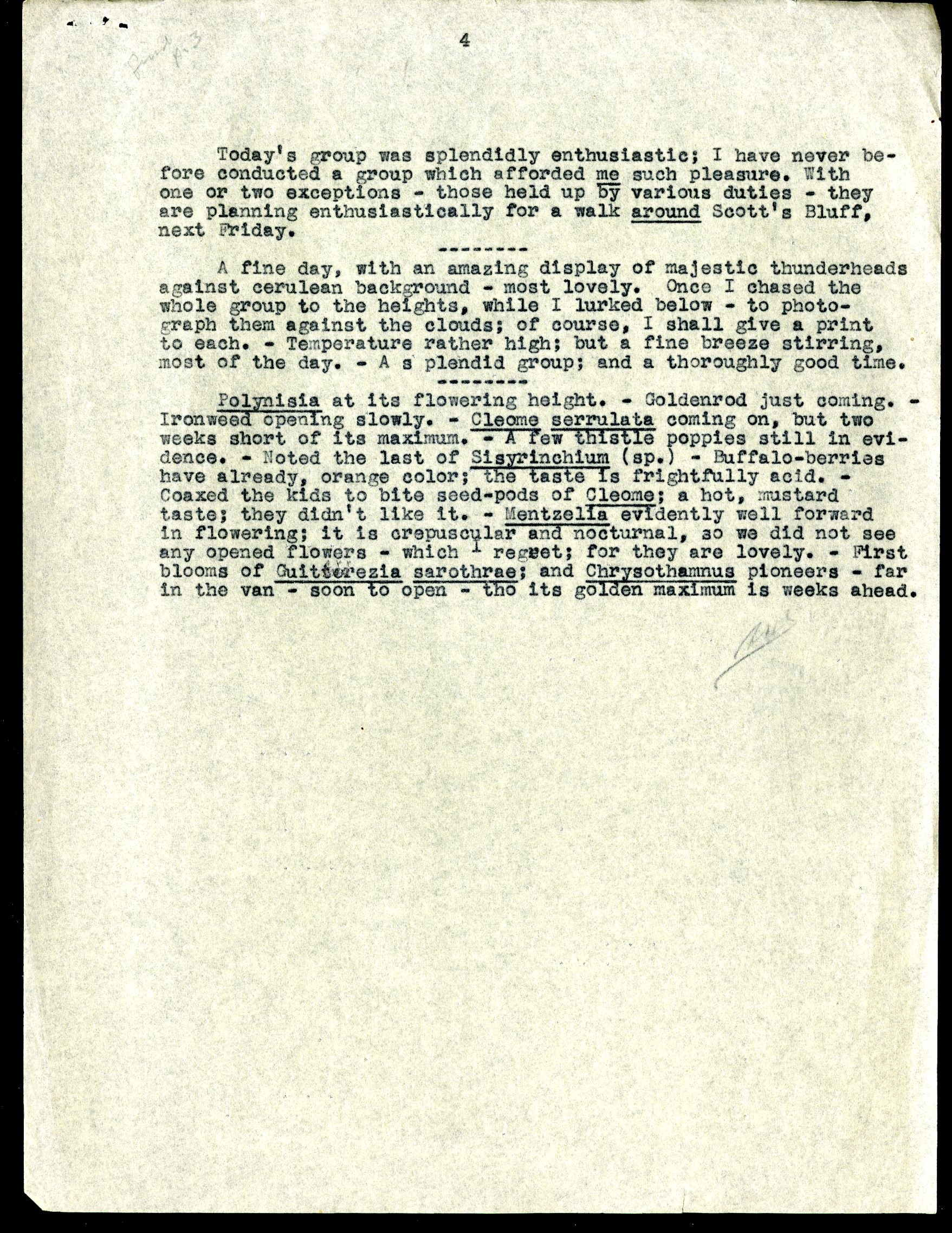
Today’s group was splendidly enthusiastic; I have never before conducted a group which afforded me such pleasure. With one or two exceptions – those held up by various duties – they are planning enthusiastically for a walk around Scott’s Bluff, next Friday.
– – – – – – – –
A fine day, with an amazing display of majestic thunderheads against cerulean background – most lovely. Once I chased the whole group to the heights, while I lurked below – to photograph them against the clouds; of course, I shall give a print to each. – Temperature rather high; but a fine breeze stirring most of the day. – A s plendid group; and a thoroughly good time.
Polynisia at its flowering height. – Goldenrod just coming. – Ironweed opening slowly. – Cleome serrulate coming on, but two weeks short of its maximum. – A few thistle poppies still in evidence. – Noted the last of Sisyrinchium (sp.) – Buffalo-berries have already, orange color; the taste is frightfully acid. – Coaxed the kids to bite seed-pods of Cleome; a hot, mustard taste; they didn’t like it. – Mentzelia evidently well forward in flowering; it is crepuscular and nocturnal, so we did not see any opened flowers – which I regret; for they are lovely. – First blooms of Gutierrezia Sarothrae; and Chrysothamnus pioneers – far in the van – soon to open – tho its golden maximum is weeks ahead.
